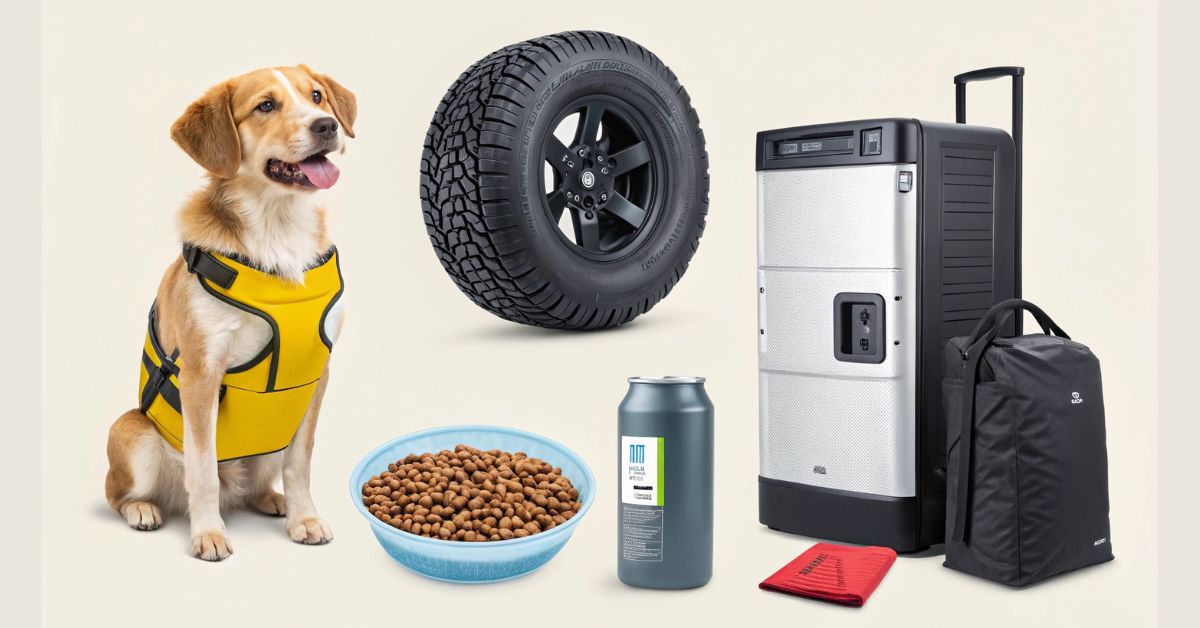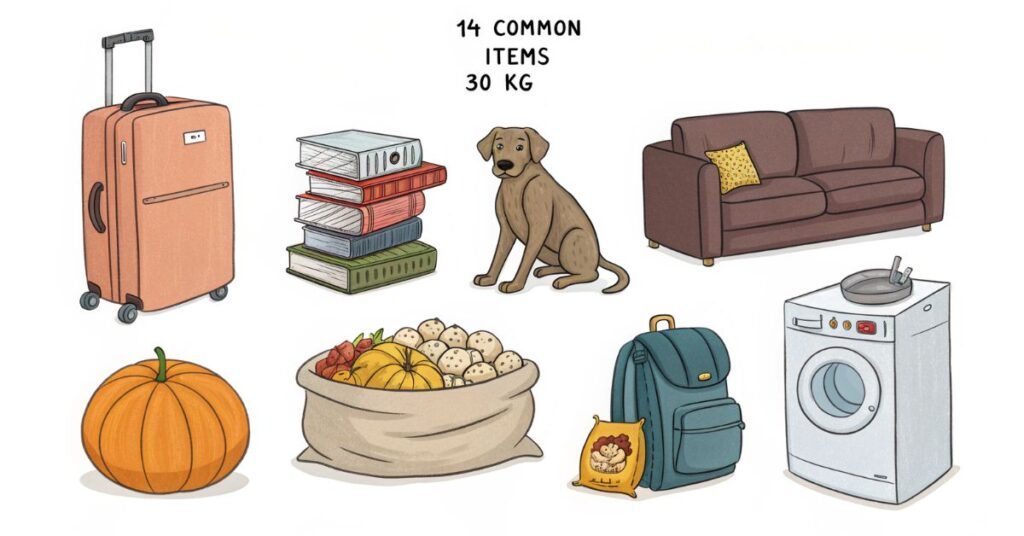Ever wondered what 20 kilograms actually feels like? Whether you’re calculating shipping costs, hitting fitness milestones, or simply trying to understand metric measurements, having tangible reference points transforms abstract numbers into real-world understanding.
Let me walk you through 14 everyday objects that hit this exact weight benchmark—each one giving you an instant mental anchor for visualizing 44 pounds of mass.
🔄 Understanding 20 Kilograms
Kilograms
Pounds
Also equals: 705.5 ounces | 3.15 stones | 196.2 Newtons
20 Kilograms in Context
The Metric-Imperial Translation
Here’s the fundamental conversion: 20 kg equals 44.09 pounds.
For most Americans, kilograms feel foreign. We grew up with pounds, ounces, and tons. However, the global marketplace—from Amazon shipping to international travel—operates primarily in metric units.
Think of it this way: if you’ve ever lifted a 40-pound bag of topsoil from Home Depot, you’re already familiar with this weight range. Add four more pounds (roughly a large pineapple), and you’ve hit 20 kg precisely.
Why This Weight Matters
Airline baggage limits typically max out at 23 kg for checked luggage on international flights. Pack to 20 kg, and you’ve built in a comfortable buffer zone.
Parents track this milestone religiously. Most toddlers reach 20 kilograms between ages 5-6, marking the transition from “easily portable” to “please walk on your own, kiddo.”
Fitness enthusiasts recognize 20 kg as a significant weightlifting benchmark—whether you’re deadlifting, squatting, or pressing. It represents meaningful resistance without entering advanced territory.
Shipping companies structure pricing tiers around these round numbers. Once your package crosses the 20 kg threshold, costs often jump substantially.
14 Common Things That Weigh 20 Kilograms
1. A Standard Car Tire (Complete Wheel Assembly)
🚗 1. Standard Car Tire (Complete Assembly)
Tire + Rim Combined
⚙️ Weight Breakdown:
- Sedan Tire: ~20 kg
- SUV Tire: ~25 kg
- Compact Car: ~17 kg
💡 Pro Tip: Heavier wheels reduce fuel efficiency by 1-2% per 100 pounds of vehicle weight.
Your vehicle’s tire and rim combination typically weighs between 18-22 kg, depending on size.
A standard sedan tire (like a 205/55R16) with its aluminum alloy wheel clocks in right around 20 kilograms. Larger SUV assemblies push closer to 25 kg, while compact car setups might sit at 17 kg.
Why does this matter? Mechanics who swap tires daily develop chronic back issues from improper lifting techniques. That seemingly manageable tire becomes a 44-pound disc of awkward, unwieldy mass.
The weight distribution affects your vehicle’s fuel efficiency too. Heavier wheel assemblies increase rotational inertia, forcing your engine to work harder during acceleration. According to the U.S. Department of Energy, reducing vehicle weight by just 100 pounds can improve fuel economy by 1-2%.
Next time you’re rotating tires, pay attention to that heft. It’s your 20 kg reference point.
2. A Medium-Sized Dog (Like a Cocker Spaniel)
🐕 2. Medium-Sized Dog
Cocker Spaniel
18-20 kg
French Bulldog
20-25 kg
Border Collie
18-20 kg
🏥 Medical Note: Veterinarians use 20 kg as a dosage threshold for many pet medications.
Picture a Cocker Spaniel trotting beside you—that adorable pup weighs almost exactly 20 kilograms.
Other breeds in this weight class include Shetland Sheepdogs (18-23 kg), French Bulldogs (typically 20-25 kg for males), and Border Collies (18-20 kg). The American Kennel Club provides detailed breed standards showing these ranges.
Here’s where it gets personal: I remember carrying my friend’s Cocker Spaniel up three flights of stairs after a paw injury. Those first two flights? Manageable. The third? My arms screamed in protest.
Veterinarians use 20 kg as a dosage threshold for medications. Many prescriptions change formulation or pill count at this weight marker, making it medically significant beyond mere numbers.
When you’re cuddling your medium-sized pup, you’re experiencing precisely what 20 kilograms feels like—warm, squirmy, and surprisingly substantial.
3. Two Bowling Balls
🎳 3. Two Bowling Balls
10 kg each
10 kg each
Total Weight
🎯 Regulation Weight Range
Minimum
6 lbs (2.7 kg)
Maximum
16 lbs (7.3 kg)
Pro Choice
14-16 lbs
Grab a regulation bowling ball from your local alley. That sphere weighs 10 kg (22 pounds) at maximum legal weight.
Stack two of them together—boom, you’ve got 20 kilograms.
The United States Bowling Congress regulates competition balls between 6-16 pounds (2.7-7.3 kg), but serious bowlers typically choose balls in the 14-16 pound range. Two maximum-weight balls slightly exceed our target, while two 11-pounders land right at 20 kg.
The material composition affects this density. Modern reactive resin bowling balls pack their weight into a smaller, denser package compared to older polyester versions. The dense inner core—often made from materials like bismuth graphite—creates the mass needed for powerful strikes.
Carrying your bowling bag to league night? If you’ve packed two balls, shoes, and accessories, you’re hauling well over 20 kilograms. Your shoulder knows the difference.
4. A Five-Gallon Water Cooler Jug (When Full)
💧 4. Five-Gallon Water Cooler Jug
🧮 Weight Calculation:
Water
18.9 kg
5 gallons
Plastic Jug
~1.1 kg
Container
Total
20 kg
⚠️ Safety Reminder: OSHA warns that lifting 50+ pounds repeatedly creates injury risk. Use proper lifting technique!
That iconic blue water jug sitting atop office coolers weighs almost exactly 20 kilograms when full.
Here’s the math: Water has a density of 1 kilogram per liter. Five gallons converts to approximately 18.9 liters. Add the rigid plastic jug itself (roughly 1 kg), and you land squarely at 20 kg total.
According to OSHA guidelines, repetitive lifting of loads exceeding 50 pounds creates significant injury risk. That water cooler replacement ritual—hoisting the jug from floor level, flipping it upside down, and threading it onto the dispenser—challenges your lower back with awkward ergonomics.
Offices nationwide have shifted toward bottom-loading water dispensers specifically because the traditional top-loading design caused so many workplace injuries.
The humble water cooler jug provides perhaps the most accessible 20 kg reference. Nearly everyone has wrestled with one.
5. A Compact Microwave Oven
📟 5. Compact Microwave Oven
0.7-1.0 cubic feet
⚙️ Weight Components:
Your countertop microwave probably weighs between 18-23 kilograms, depending on capacity.
Standard 0.7-1.0 cubic foot models—the size you’d find in most apartments or dorm rooms—typically clock in around 20 kg. The magnetron (the component generating microwaves) accounts for significant mass, along with the transformer and metal chassis.
Brands like Panasonic, GE, and Samsung publish exact specifications. For example, the popular Panasonic NN-SN936B (2.2 cubic feet) weighs 21.6 kg, while more compact 700-watt models hover around 18 kg.
Moving day reveals the microwave’s true weight. That appliance you casually use daily becomes a awkward 44-pound box with no good handholds. The weight concentrates on one side where the magnetron sits, creating balance challenges.
Interestingly, higher-wattage microwaves often weigh less than their lower-powered counterparts due to modern inverter technology replacing heavy transformers.
6. A Large Bag of Premium Dog Food
🍖 6. Large Bag of Premium Dog Food
⏱️ How Long Does 20 kg Last?
Large Breeds
2-3 weeks
Medium Breeds
4-6 weeks
Small Breeds
2+ months
💰 Cost Savings: Buying 44-lb bags saves 20-30% compared to smaller packages!
Walk into any Petco or Chewy warehouse, and you’ll find 44-pound bags of dog food lining the shelves.
Premium brands like Blue Buffalo, Taste of the Wild, and Orijen sell their large-breed formulas in this exact size. The 44-lb designation (20 kg) represents a sweet spot for bulk buyers—substantial savings per serving without requiring forklift-level logistics.
For households with large or multiple dogs, a 20 kg bag lasts roughly 2-3 weeks. Smaller breeds stretch it to two months.
The weight-to-volume ratio varies significantly by formulation. Grain-free, protein-dense kibble packs more mass into less space compared to grain-inclusive varieties. A 20 kg bag of dense salmon formula might fill a 5-gallon bucket, while a grain-heavy formula requires a 7-gallon container.
Cost-conscious pet owners appreciate the economics: buying in 44-pound increments typically saves 20-30% compared to smaller bags.
Storage tip: keep that heavy bag off the floor using a wheeled dolly or elevated platform. Moisture and pests lurk at ground level.
7. A Toddler (Around 5-6 Years Old)
👶 7. A Toddler (Around 5-6 Years Old)
📊 CDC Growth Milestones
Years
18-19 kg
Years
20 kg
Years
21-22 kg
🚗 Car Seat Weight Limits:
- Rear-facing: Up to 18 kg
- Forward-facing: 9-22 kg
- Booster seats: Minimum 18 kg
Most kindergarteners hit 20 kilograms right around their fifth or sixth birthday.
The CDC growth charts show that boys typically reach this milestone slightly earlier than girls, though individual variation is enormous. A tall four-year-old might exceed 20 kg, while a petite seven-year-old might not hit it yet.
Parents remember this transition vividly. Your child transforms from a portable bundle you could carry indefinitely into a surprisingly heavy human who needs to walk on their own two feet.
Car seat regulations key into these weight thresholds. Many booster seats have minimum weights around 18 kg (40 pounds), while forward-facing car seats often max out at 22-29 kg depending on the model.
Pediatricians track weight percentiles obsessively during early childhood. A child at the 50th percentile for weight at age 5 typically weighs right around 20 kilograms—literally the median American kindergartener.
Carrying your 20 kg child up the stairs, through the airport, or out of the car when they’ve fallen asleep gives you the most emotionally resonant reference point on this list.
8. Four Gallons of Paint
🎨 Four Gallons of Paint
📐 Coverage Area
4 gallons covers
1,400-1,600
square feet
⚖️ Weight per Gallon
Latex Paint:
5 kg (11 lbs)
Oil-Based:
5.5 kg (12 lbs)
⚠️ Safety Tip: Don’t carry more than 2 gallons (10 kg) when climbing ladders!
Planning a home renovation? Four one-gallon paint cans weigh approximately 20 kilograms combined.
Latex paint density sits around 5 kg per gallon (11 pounds), making four gallons equal 20 kg. Oil-based paints run slightly heavier at 5.5 kg per gallon due to different resin compositions.
Professional painters transport paint by the five-gallon bucket (25 kg) for efficiency, but homeowners typically buy in single-gallon increments. Stack four of those cans in your car trunk, and you’re hauling our target weight.
Coverage calculations matter here. One gallon typically covers 350-400 square feet with a single coat. Four gallons therefore handle about 1,400-1,600 square feet—enough for several medium-sized rooms.
The EPA regulates paint disposal because of volatile organic compounds (VOCs). Those four gallons represent not just 20 kg of weight but also environmental responsibility once empty.
Weight considerations affect your project planning. Climbing ladders while carrying paint? Contractors recommend keeping individual loads under 2 gallons (10 kg) for safety.
9. A Weighted Fitness Vest (Fully Loaded)
🦺 9. Weighted Fitness Vest (Fully Loaded)
📈 Training Benefits
Calorie Burn
+12%
vs. unweighted
Heart Rate
+10-15
beats per minute
Strength Gains
Higher
muscle activation
⚠️ Safety Note: Start with 10 kg if new to weighted training. Avoid if you have joint issues.
CrossFit athletes and military trainees regularly don 20 kg weighted vests during conditioning workouts.
These vests distribute weight across your torso using small steel or sand-filled packets inserted into pockets. Brands like CAP Barbell, RUNFast, and Hyperwear manufacture adjustable vests maxing out at 44 pounds.
The physiological impact is substantial. Research published in the Journal of Strength and Conditioning Research found that wearing a 20 kg vest during bodyweight exercises increases caloric expenditure by approximately 12% compared to unweighted movements.
Military ruck marches simulate combat load conditions. A fully-loaded infantry pack approaches 35-45 kg, but training progressions often start with 20 kg to build foundational strength without destroying joints.
Your cardiovascular system works significantly harder supporting the additional mass. Heart rate increases by 10-15 beats per minute on average during weighted walks or runs.
Safety consideration: orthopedic specialists warn against weighted vest usage for individuals with existing knee or hip issues. That 20 kg multiplies force through your joints with every step.
Start with 10 kg if you’re new to weighted training. Work up gradually to avoid overuse injuries.
10. A Large Desktop Computer Tower (Gaming Rig)
🖥️ 10. Large Desktop Computer Tower
🔧 Component Weight Breakdown
💡 Compare: Modern laptops weigh just 1-2 kg – that’s 90% lighter!
Enthusiast gaming PCs routinely exceed 20 kilograms once fully assembled.
Let’s break down the components: a high-end graphics card like the NVIDIA RTX 4090 weighs 2.2 kg alone. Add a robust CPU cooler (1 kg), full ATX motherboard (1.5 kg), power supply (2-3 kg), multiple hard drives (1 kg each), and a steel case (8-10 kg)—suddenly you’re approaching 20 kg total.
Custom water-cooling loops push weights even higher. The coolant itself adds kilograms, and radiators are dense copper and aluminum constructions.
Compare this to modern laptops weighing 1-2 kg, and you appreciate how desktop computing prioritizes performance over portability.
LAN parties—where gamers transport their entire setups to group events—turned into weightlifting sessions. Hauling a 20 kg tower, 5 kg monitor, and peripherals tests your commitment to multiplayer gaming.
Case manufacturers now advertise built-in handles specifically for transport. Brands like Corsair and Cooler Master design “portable” towers that acknowledge the weight reality.
The PC gaming community jokes that upgrading from integrated graphics to a dedicated GPU adds more weight than performance initially.
11. Two Car Batteries
🔋 11. Two Car Batteries
Single Battery
Single Battery
Two Batteries
♻️ Recycling Facts
Recycling Rate
Highly Recyclable
⚡ EV Comparison: A Tesla Model 3 battery weighs 480 kg – equal to 24 car batteries!
A standard lead-acid car battery weighs approximately 18-20 kg (40-45 pounds). Two batteries equal 36-40 kg, but a single heavy-duty truck battery can hit 22-25 kg alone.
The weight comes from lead plates submerged in sulfuric acid electrolyte solution. Modern absorbed glass mat (AGM) batteries weigh similarly despite using different internal architecture.
Automotive technicians handle batteries constantly, making proper lifting technique essential. The National Institute for Occupational Safety and Health (NIOSH) recommends two-person lifts for batteries exceeding 18 kg.
Recycling is mandatory in most states. Lead is highly toxic, but also extremely recyclable—over 99% of lead-acid batteries are recycled in the U.S., making them one of the most successfully recycled consumer products.
Electric vehicle batteries dwarf these numbers. A Tesla Model 3 battery pack weighs approximately 480 kg—roughly 24 traditional car batteries. The weight penalty trades fossil fuel dependence for lithium-ion storage.
The humble 12-volt battery sitting under your hood provides accessible weight reference. Pick one up at AutoZone, and you’ll understand 20 kg intimately.
12. A Folded Tent with Camping Gear
⛺ 12. Folded Tent with Camping Gear
📦 What’s Included?
6-8 Person Tent
8 kg
Sleeping Bags
4 kg
Cooking Gear
3 kg
Food & Water
4-5 kg
🏞️ Fun Fact: Over 40 million Americans go camping annually – most are car campers carrying 20+ kg of gear!
A family-sized camping tent (6-8 person capacity) with poles, stakes, and rainfly weighs 18-22 kg when packed.
Popular models like the Coleman Sundome 6-Person tent weigh 8 kg alone. Add two sleeping bags (2 kg each), sleeping pads (1 kg each), cooking gear (3 kg), and food for a weekend trip (3-4 kg)—you’ve assembled a 20 kg camping package.
Backpackers obsess over weight reduction, often spending hundreds of dollars to shave a few kilograms from their load. Car campers enjoy the luxury of not caring—that 20 kg tent rides in your trunk, not on your back.
The outdoor recreation industry reports over 40 million Americans camp annually, according to the Outdoor Foundation. Most are car campers carrying heavier, more comfortable gear.
Weight distribution matters when packing. That 20 kg tent bag shouldn’t occupy your backpack’s top—it belongs at the bottom for stability.
Modern tent materials have improved dramatically. Older canvas tents from the 1980s weighed twice as much for similar capacity. Ripstop nylon and aluminum poles revolutionized portable shelter.
13. A Large Bag of Rice (44-Pound Commercial Size)
🌾 13. Large Bag of Rice (44-Pound)
🍽️ Nutritional Yield
Total Servings
Family of 4
Shelf Life*
*Shelf life depends on storage conditions and packaging quality.
Wholesale clubs sell 20 kg bags of rice as pantry staples for large families or meal preppers.
Rice varieties affect density slightly. Long-grain white rice weighs approximately 0.75 kg per liter, while short-grain sushi rice is denser at 0.85 kg per liter. A 20 kg bag contains roughly 26-27 liters of volume.
Nutritional yield is impressive: 20 kg of rice provides approximately 200-220 servings at 100g per serving (cooked weight). For a family of four eating rice three times weekly, that’s nearly a year’s supply.
Emergency preparedness advocates stockpile rice because of its shelf stability. Properly stored in airtight containers with oxygen absorbers, white rice lasts 10-30 years. Brown rice spoils faster due to natural oils but offers superior nutrition.
Cultural significance runs deep. Rice forms the caloric foundation for over half the global population. In many Asian households, a 20 kg bag represents not just food but cultural continuity.
Lifting technique matters. That seemingly manageable bag becomes unwieldy quickly. Bend at the knees, hug it close to your body, and avoid twisting while carrying.
Storage tip: divide the 20 kg into smaller containers immediately. Managing 5 kg portions beats wrestling the full bag repeatedly.
14. Twenty Hardcover Books
📚 14. Twenty Hardcover Books (44-Pound Library)
📦 Book Weight Insights
Book Range
Total Weight
Library of Congress
*Book weight varies: novels ~0.8kg, textbooks 1.5-2kg, coffee table books often exceed 2kg.
Stack twenty average hardcover novels (roughly 1 kg each), and you’ve built a 20 kg library.
Book weight varies enormously. A 300-page novel in standard trim size weighs 0.7-0.9 kg, while coffee table photography books can exceed 2 kg each. Academic textbooks often hit 1.5-2 kg due to paper quality and dimensions.
Moving companies charge by weight, making book collections expensive to relocate. Professional movers groan when they see floor-to-ceiling bookcases—those literary treasures become backbreaking cardboard boxes.
The shift toward digital reading partly stems from weight considerations. A Kindle weighs 205 grams yet holds thousands of books. Twenty physical hardcovers occupy a full cardboard box and strain your lifting capacity.
Libraries manage millions of kilograms. The Library of Congress houses over 17 million books—if each averages 0.8 kg, that’s 13.6 million kilograms of books (13,600 metric tons).
Book collectors understand this intimately. Building a personal library means building weight-bearing shelving. Standard residential floors handle 40 pounds per square foot (195 kg per square meter)—but concentrated book weight can exceed this, requiring structural reinforcement.
For bibliophiles, twenty hardcovers represents both intellectual wealth and physical burden.
Reference Points
🎯 Practical Applications of Knowing 20 kg
Fitness Goals
- ✓ Beginner weightlifting milestone
- ✓ Progressive resistance tracking
- ✓ Body weight loss reference
Travel & Logistics
- ✓ Airline baggage limits (23 kg)
- ✓ Shipping cost calculations
- ✓ Moving day estimations
Parenting
- ✓ Child development tracking
- ✓ Car seat weight limits
- ✓ Stroller capacity planning
Fitness and Health Goals
Personal trainers use 20 kg as a beginner-to-intermediate threshold for compound movements.
If you’re deadlifting or squatting 20 kg (just the barbell plus small plates), you’re establishing foundational strength. Within 6-8 weeks of consistent training, most adults progress beyond this weight.
Weight loss journeys benefit from these reference points. Losing 20 kilograms represents a major health transformation—that’s equivalent to carrying a medium-sized dog everywhere you go. Shedding that mass reduces joint stress, improves cardiovascular function, and often reverses metabolic conditions.
Physical therapists prescribe progressive resistance using 20 kg milestones. Recovering from knee surgery? Your rehabilitation might progress from bodyweight exercises to 10 kg resistance bands, eventually reaching 20 kg functional movements.
Travel and Logistics
International airline policies cluster around 20-23 kg for checked baggage.
Airlines like Lufthansa, Emirates, and British Airways typically allow 23 kg (50 pounds) in economy class. Pack to 20 kg, and you’ve built buffer room for souvenirs or unexpected items.
Budget carriers charge exorbitant overweight fees—sometimes $100+ per kilogram over the limit. A portable luggage scale costing $15 prevents expensive airport surprises.
Shipping costs escalate dramatically at weight thresholds. USPS, FedEx, and UPS structure pricing tiers around these round numbers. A 19 kg package might cost $40, while a 21 kg package jumps to $65.
Online sellers understand this intimately. Splitting inventory into two 10 kg shipments sometimes costs less than one 20 kg package due to pricing brackets.
Child Development and Parenting
Car seat weight limits pivot around 18-22 kg (40-50 pounds).
Rear-facing convertible seats typically accommodate children up to 18 kg, while forward-facing seats start at 9-22 kg depending on the model. Booster seats require a minimum of 18 kg in most jurisdictions.
Stroller capacity limits matter for parents of larger toddlers. Most standard strollers max out at 18-23 kg (40-50 pounds). Once your child exceeds this, you’re shopping for heavy-duty models or encouraging independent walking.
The transition from “portable” to “pedestrian” happens around this weight. Babywearing enthusiasts hit carrying capacity limits—structured carriers typically accommodate children up to 20 kg, though caregiver comfort usually fails earlier.
Pediatric dosing for medications often uses 20 kg as a threshold. Prescription instructions might read: “For children under 20 kg: take one tablet. For children over 20 kg: take two tablets.”
How to Estimate 20 Kilograms Without a Scale
Your body provides surprisingly accurate proprioceptive feedback for weight estimation.
Lift known reference objects repeatedly—that bag of dog food, those paint cans, your toddler. Your muscular and nervous systems calibrate to these weights quickly.
The “comparison method” works well: stack smaller known weights until you approximate 20 kg. Four 5-kg dumbbells, two 10-kg kettlebells, or twenty 1-kg items all equal your target.
Smartphone apps like “Weight Meter” or “Smart Measure” attempt photographic weight estimation using object recognition and size comparison algorithms. Accuracy varies wildly—expect 20-30% margins of error—but they provide ballpark figures for rough planning.
Commercial shipping teaches weight estimation through experience. Postal workers develop uncanny accuracy determining if packages exceed weight limits just by lifting them. You can cultivate this skill through practice.
For precision-critical applications—medical dosing, engineering, international shipping—always use calibrated scales. For everyday reference and estimation, your mental library of 20 kg objects suffices.
FAQ’s
What does 20 kg weigh?
20 kilograms weighs 44.09 pounds or approximately 705.5 ounces in imperial measurements.
For readers in the UK, that converts to 3.15 stones—a common weight measurement for people.
From a physics perspective, mass and weight differ slightly. Mass (20 kg) remains constant regardless of location, while weight measures gravitational force. On Earth’s surface, 20 kg of mass produces approximately 196.2 Newtons of force (20 kg × 9.81 m/s²).
This distinction matters in scientific contexts but rarely affects everyday usage. When someone asks “what does 20 kg weigh,” they’re asking about Earth-bound gravitational force—and the answer is consistently 44 pounds.
What common items weigh a kilogram?
Single-kilogram reference objects populate every household.
A liter of water weighs exactly 1 kilogram by definition—this formed the basis for metric system standardization in 1795.
Your laptop computer probably weighs 1-2 kg depending on size. Most 13-inch laptops land around 1.3 kg, while 15-inch models push 1.8-2 kg.
Standard textbooks weigh 1-1.5 kg. That physics or history tome you lugged through college likely hit this range.
A small pineapple typically weighs 0.9-1.2 kg, making it a surprisingly accurate (and edible) reference weight.
Construction bricks are deliberately manufactured around 1 kg for ergonomic handling. Standard modular bricks weigh 0.9-1.1 kg.
Five medium apples combined weigh approximately 1 kg, though fruit varies significantly by variety and ripeness.
What is the same as 20 kg?
Beyond the 14 detailed examples above, other 20 kg equivalents include:
- 20 liters of water (though you’d need a substantial container)
- A small adult bicycle (road bikes typically weigh 8-10 kg, but mountain bikes with full suspension approach 18-22 kg)
- A case of wine bottles (12 bottles at 1.5 kg each equals 18 kg, plus case weight brings it to 20 kg)
- A medium-sized suitcase when fully packed for a two-week international trip
- Ten large cans of paint (2 kg each)
- A bag of cement mix (common 50-pound/22.7 kg bags exceed it slightly)
- Your washing machine drum (the inner drum component alone, not the full appliance)
Creative combinations work too: a gallon of milk (3.8 kg) plus a bag of flour (2.3 kg) plus a dozen eggs (0.7 kg) plus fourteen other grocery items sums to 20 kg. Your shopping cart accumulates weight faster than you’d expect.
What does 20 kg represent?
20 kilograms represents a fundamental mass measurement in the International System of Units (SI).
Scientifically, kilogram is one of seven base SI units. Until 2019, it was defined by a physical artifact—the International Prototype Kilogram stored in France. Now it’s defined using the Planck constant, a quantum mechanical relationship ensuring universal consistency.
In practical terms, 20 kg represents:
- A meaningful fitness benchmark for beginners
- A common shipping weight threshold affecting costs
- A pediatric milestone in child development
- A manageable load for single-person carrying
- The boundary between “easily portable” and “requires assistance”
Culturally, measurement system adoption varies. The United States officially recognizes metric units through the Metric Conversion Act of 1975 but predominantly uses imperial measurements in daily life. This creates translation challenges—hence guides like this one.
Industrial contexts universally employ metric units. Engineering specifications, scientific research, international trade—all operate in kilograms regardless of location.
What animal weighs 22 kg?
Several animal species cluster around 22 kilograms (48.5 pounds):
Domestic animals:
- English Bulldogs: Males typically weigh 23-25 kg
- Border Collies: Larger males reach 20-23 kg
- Beagles: The upper range hits 22 kg for robust males
Wild mammals:
- Raccoons: Exceptional specimens reach 22-23 kg, though 8-12 kg is more typical
- Beavers: Large adults weigh 20-25 kg
- Bobcats: Males average 18-24 kg depending on region
- Canadian Lynx: Adults range 18-24 kg
Marine life:
- Emperor Penguin chicks: Reach 22 kg before fledging
- Harbor seal pups: Weigh 20-25 kg at weaning
- Sea otters: Large males approach 22-30 kg
Exotic species:
- Capybaras: Smaller adults (females) weigh around 22-25 kg
- Wallabies: Red-necked wallabies average 20-25 kg
- Sloths: Large three-toed sloths reach 20-22 kg
Zoo visitors often underestimate animal weights. That “small” wallaby hopping around weighs as much as your toddler. The penguin chick looks fluffy but carries serious mass underneath the down.
Wildlife biologists use weight as a health indicator. A 22 kg bobcat is robust and well-fed; a 14 kg adult likely faces nutritional stress.
What is the weight of a 20 KG object?
This question reveals confusion between mass and weight—a physics distinction worth clarifying.
Mass (measured in kilograms) represents the quantity of matter in an object. This remains constant regardless of location.
Weight (measured in Newtons) represents the gravitational force acting on that mass. Weight varies with gravitational field strength.
On Earth’s surface:
- Weight = mass × gravitational acceleration
- Weight = 20 kg × 9.81 m/s²
- Weight = 196.2 Newtons
This translates to 44.09 pounds-force in imperial units.
On the Moon (gravitational acceleration = 1.62 m/s²):
- Weight = 20 kg × 1.62 m/s²
- Weight = 32.4 Newtons
- The same 20 kg mass would feel like only 7.3 pounds
On Jupiter (gravitational acceleration = 24.79 m/s²):
- Weight = 20 kg × 24.79 m/s²
- Weight = 495.8 Newtons
- That 20 kg mass would feel like 111.5 pounds
In microgravity environments (International Space Station), the 20 kg object still possesses 20 kg of mass—inertia still matters—but weighs effectively zero. Astronauts can “float” massive objects, yet accelerating or stopping them requires significant force.
This distinction matters in engineering and space exploration but rarely affects daily conversation. When you ask “how much does this weigh,” you’re implicitly asking about Earth-bound gravitational force.

Welcome to Swiftnis.com! I manage this site to provide accurate and easy-to-understand measurement guides. My goal is to make measurements simple for everyone. Whether you need Conversions, Tools, or Tips, I’m here to help. Enjoy exploring and measuring with confidence!
















